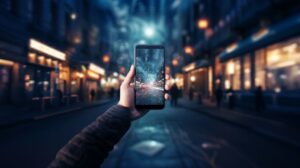The convergence of the Internet of Things (IoT) and Artificial Intelligence (AI) has transformed various sectors, and one area that has greatly benefited from this collaboration is augmented reality (AR). AR is an innovative technology that overlays virtual elements onto the real world, enhancing our perception and interaction with the environment. By harnessing the power of IoT and AI, AR has taken significant strides forward, opening up a world of possibilities and revolutionizing industries across the board.
Connecting the Physical and Digital Worlds
IoT forms the backbone of augmented reality by connecting physical objects to the digital realm. IoT devices, equipped with sensors and connectivity capabilities, gather real-time data from the environment and transmit it to the cloud for processing. This information serves as a foundation for AI algorithms to generate meaningful insights and augment the user’s perception of reality.
By leveraging IoT devices such as cameras, wearables, and smart glasses, AR applications can seamlessly integrate virtual objects and information into our surroundings. For example, in the retail sector, smart mirrors equipped with IoT sensors can detect the items a customer is trying on and display complementary accessories or outfit suggestions in real-time. This fusion of IoT and AR enables an immersive and personalized shopping experience, blurring the lines between the physical and digital worlds.
Enhancing Real-Time Interactions
The integration of AI algorithms in AR systems takes the experience to a whole new level. AI-powered computer vision algorithms can analyze vast amounts of visual data captured by IoT devices in real-time, enabling accurate object recognition, tracking, and scene understanding. This capability allows AR applications to overlay virtual objects with precision and respond to user actions seamlessly.
For instance, AR-powered navigation systems can combine IoT-generated data such as GPS coordinates, traffic information, and real-time camera feeds to provide users with interactive directions. AI algorithms process this data, understand the user’s location, and project virtual arrows or signposts onto the real world, guiding them along the optimal route. By merging IoT’s real-time data acquisition with AI’s intelligent processing, AR applications can enhance user interactions and deliver context-aware experiences.
Industrial Applications and Efficiency
The symbiotic relationship between IoT, AI, and AR has also brought about remarkable advancements in industrial settings. By equipping workers with AR-enabled devices and integrating them with IoT infrastructure, enterprises can streamline processes, increase safety, and boost overall efficiency.
For example, in manufacturing plants, IoT sensors embedded in machines can collect data on performance, temperature, and maintenance needs. This data is then analyzed by AI algorithms that identify patterns, predict failures, and optimize operations. AR overlays can provide real-time instructions to workers, highlighting specific parts, demonstrating assembly processes, and alerting them to potential hazards. This integration of IoT, AI, and AR not only improves productivity but also reduces errors and minimizes downtime.
Healthcare, Education, and Beyond
The impact of IoT and AI in AR extends beyond industrial applications. In healthcare, for instance, IoT devices such as wearables can collect patient data, which AI algorithms interpret to provide real-time insights to doctors and caregivers. AR technology can overlay medical information and visualizations onto a patient’s body, aiding in diagnosis, surgical procedures, and medical training.
Likewise, in education, IoT sensors in classrooms can capture data on student engagement, while AI algorithms analyze it to personalize the learning experience. AR can then be employed to create interactive educational content, enabling students to explore complex subjects in a visual and immersive manner.
Conclusion
The synergy between IoT and AI has unlocked a world of possibilities in augmented reality, revolutionizing industries and transforming the way we perceive and interact with the world. By seamlessly integrating physical and digital elements, AR powered by IoT and AI enhances real-time interactions, improves efficiency in industrial settings, and finds applications in healthcare, education, and beyond.
As we move forward, the continued advancement of IoT and AI technologies will fuel the growth of augmented reality, opening new doors for innovation and transforming numerous industries. The future of AR lies in the collaboration of these cutting-edge technologies, and the possibilities are limited only by our imagination.











